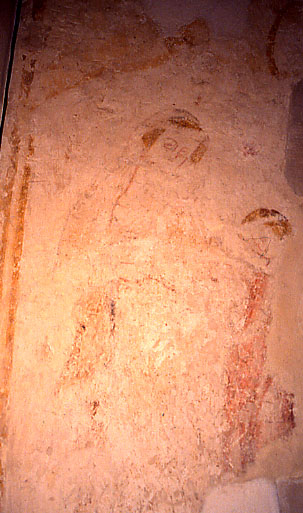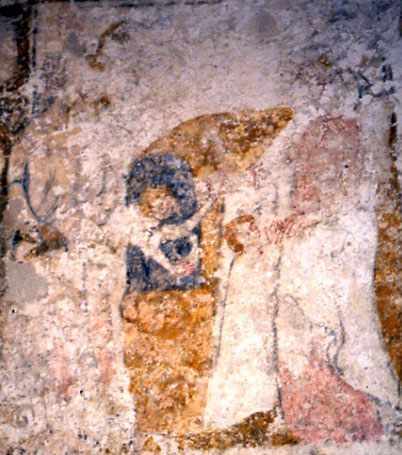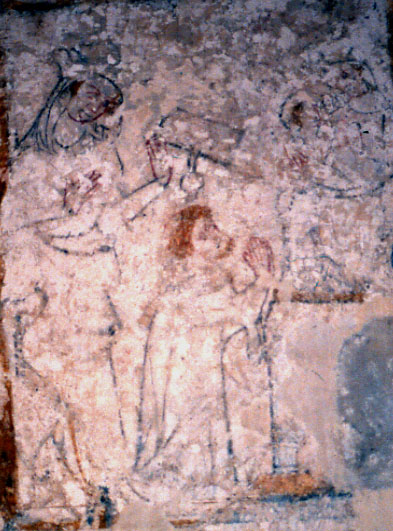Chalfont St Giles, Buckinghamshire (†Oxford) c.1330
St Anne Teaching the Virgin to Read
Miracles of the Virgin

The story of St Anne teaching the Virgin to read is not common by any means, but of the many legends about Mary’s youth this is nevertheless the most frequently found in wall painting. The Chalfont St Giles example, on the east wall of the south aisle, to the left of an open archway, is very faint now, but it shows St Anne, seated, at the left, with the much smaller figure of the young Virgin standing at her knee on the right. The saint’s head is inclined towards her daughter, and there was obviously once a book, now faded into invisibility, held between them.
The Virgin herself, head bowed over the book, wears a red robe and, like her mother, has a band around her forehead holding her veil or headress in place, much as she has at Corby Glen, where it is much clearer. As usual, the garments of the two are those of devout ladies of the day.
Much, much rarer are the accompanying scenes at Chalfont depicting pious stories of miracles performed by the Virgin. Some of these are now hopelessly obscure – one, opposite the the scene of St Anne and the Virgin on the right-hand side of the arch has as its sole identifiable detail an extended right hand, and another scene below this has only a small figure, probably an angel, in its top left hand corner. One of these probably showed the story, recorded here, of Theophilus of Adana, who was released from his pact with the Devil by the Virgin.

Around the right angle, however, on the south wall, are some clearer paintings. The first, shown at the right, fragmentary and only relatively clear, is a rare glimpse of one of the more fanciful medieval legends of the Virgin, the story of the Jewish boy of Bourges in France put in his glass-maker father’s furnace as punishment for receiving the Holy Sacrament.¹
In the photograph at the left, both the Virgin and the boy appear twice, in accordance with the standard medieval practice whereby succeeding events in a story involving the same people are narrated in separate ‘moments’.
The Virgin, reduced to traces only, stands at the left, looking towards the centre of the painting where an arched dark blue opening surrounded by yellow represents the furnace. The head, shoulders, arms and right hand (with the fingers showing red) of the child inside are fairly clear against the blue background.

At the right, the Virgin, in a red robe and white cloak, appears again, holding out her right arm and hand to pull the child from the furnace while, in the next ‘moment’ in the narrative, the rescued child, in a white robe, stands before her, hands extended in prayer.
The remaining miracle is described by Tristram² as ‘the Legend of the Youth betrothed to the Virgin’. The Virgin, crowned as Queen of Heaven, stands at the left, hands raised in something approaching consternation. Further right a young man kneels beside a lectern and in front of an altar with a statue of the Virgin and Child on it.
This is almost certainly the story of a youth who slipped the ring given to him by his beloved onto the finger of a statue of the Virgin to keep it safe while he played at ball with his friends. The statue curled its finger around the ring and would not release it. There is more than one sequel to the story, which probably comes from the Cantigas de Sancta Maria of Alfonso the Wise of Castile and Leon (1221-84).
The link will take you to the wall paintings of these and other Marian miracles in Winchester Cathedral. Their quality is superb, but they date from about 150 years after the Chalfont St Giles example.
There are more paintings in the church, including Herod’s Feast, with Salome, and The Creation of the Animals/Fall & Expulsion from Eden, both of which are now on the site. Others, including a Tree of Jesse, are still to come.
¹ The horrible story is one of a vast number used to justify medieval anti-Semitism. More than one chronicler, including the 6th century French historian and bishop Gregory of Tours, relates it. The original location of the story is Constantinople, and another version has the events taking place in Pisa.
² Tristram II, p. 151